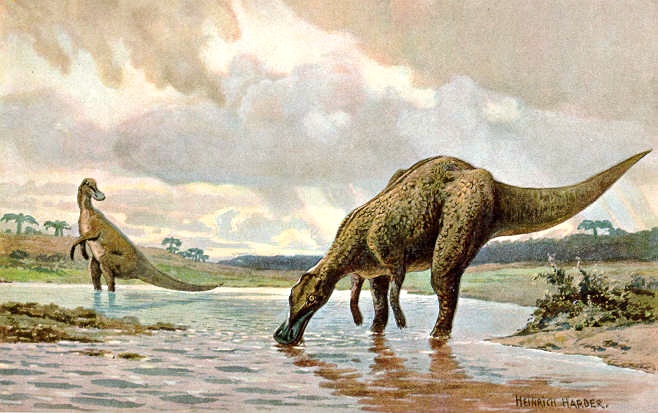Dinosaurs have captivated our imagination for generations, but until recently, their true colors remained a mystery. Scientists traditionally depicted these prehistoric creatures with speculative coloration based on modern reptiles. However, groundbreaking discoveries in the field of paleontology have revolutionized our understanding of dinosaur appearance. Recent research into fossil pigments has revealed that the dinosaur world was far more vibrant and colorful than previously thought. These new techniques allow scientists to detect melanosomes—microscopic structures containing melanin pigments—preserved in exceptional fossils, giving us unprecedented insights into the actual colors that adorned these ancient animals. Let’s explore the fascinating world of colorful dinosaurs and the cutting-edge science revealing their true hues.
The Science Behind Dinosaur Color Detection
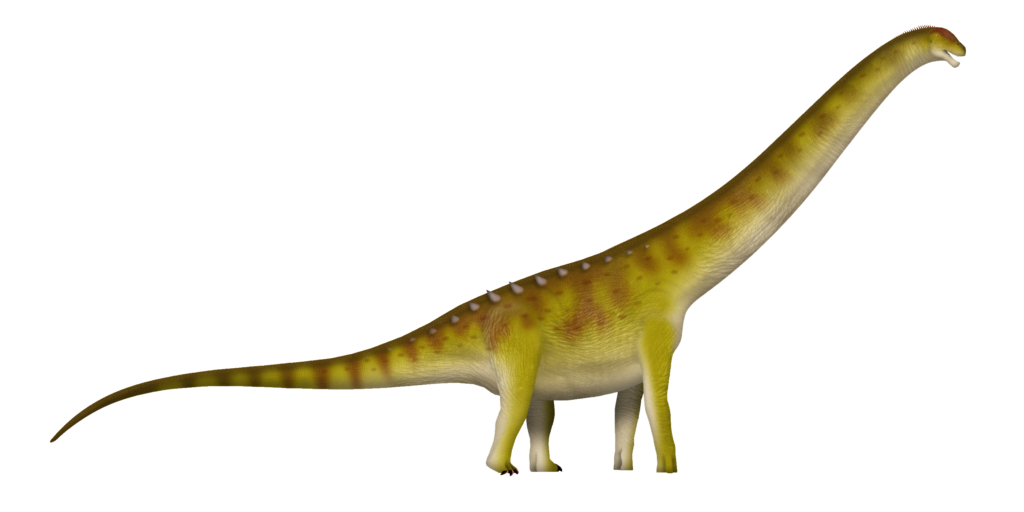
The ability to determine dinosaur coloration represents one of paleontology’s most significant breakthroughs in recent decades. Scientists now use sophisticated techniques like scanning electron microscopy and energy-dispersive X-ray spectroscopy to identify preserved melanosomes in exceptionally well-preserved fossils. These tiny cellular structures contain melanin, the same pigment that colors human hair and skin, and their shape correlates with specific colors—rod-shaped melanosomes typically indicate black or gray, while spherical ones suggest red or brown hues. By mapping the distribution and shapes of these microscopic structures, researchers can reconstruct color patterns with surprising accuracy. This methodology, first applied to dinosaur fossils in 2010, has opened an entirely new window into prehistoric life, allowing paleontologists to move beyond skeletal anatomy into the realm of appearance and behavior.
Microraptor: The Iridescent Crow-Like Dinosaur

The microraptor, a crow-sized dinosaur from Early Cretaceous China, made headlines when researchers discovered it possessed iridescent black feathers similar to modern ravens. This four-winged dinosaur exhibited a glossy, metallic sheen that would have glinted in sunlight as it moved. Analysis of its exceptionally preserved fossils revealed densely packed melanosomes arranged in a pattern consistent with iridescence rather than simple black coloration. This discovery suggests Microraptor’s plumage may have played a role in display behaviors, similar to today’s birds. The presence of iridescent feathers in a dinosaur that lived approximately 120 million years ago indicates that complex color displays evolved much earlier in the theropod lineage than previously thought. The microraptor’s sleek appearance challenges earlier conceptions of dinosaurs as dull-colored reptiles.
Sinosauropteryx: The First Dinosaur With Confirmed Colors

Sinosauropteryx holds the distinction of being the first dinosaur to have its colors scientifically reconstructed. This small theropod from Early Cretaceous China featured a striking pattern of rusty-orange and white rings along its tail. Researchers identified two types of melanosomes in the exquisitely preserved fossils—spherical pheomelanosomes indicating reddish-brown coloration and an absence of melanosomes in areas that were likely white. The alternating bands created a distinct “ringed tail” appearance that may have served in species recognition or social signaling. Beyond its tail, Sinosauropteryx also sported a “bandit mask” facial pattern and countershading—darker coloration on its back transitioning to lighter underparts—a camouflage strategy commonly observed in modern animals. This groundbreaking research, published in 2010, fundamentally changed our understanding of dinosaur appearance.
Psittacosaurus: The Camouflaged “Parrot Lizard”
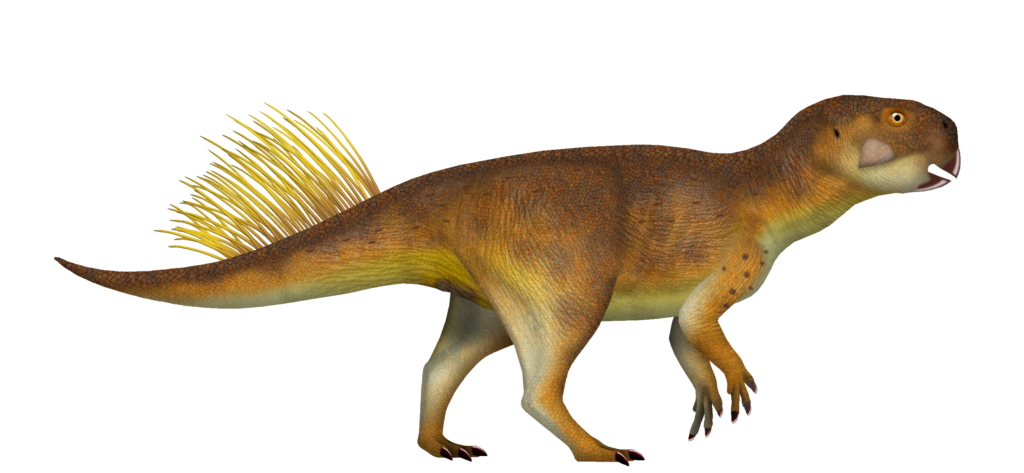
Psittacosaurus, a dog-sized relative of Triceratops, revealed one of the most sophisticated color patterns yet discovered in any dinosaur. A remarkably preserved specimen allowed scientists to reconstruct its coloration with unprecedented detail, showing a reddish-brown upper body contrasting with a lighter underbelly—a pattern called countershading that helps conceal animals in natural light conditions. More remarkably, computer modeling demonstrated that this particular countershading pattern would have provided optimal camouflage in a forested environment with dappled light rather than in open plains. The dinosaur’s skin also featured larger pigment patches and subtle color variations adapted to its specific habitat. Additional analysis revealed darker coloration around the cloacal region and lighter pigmentation on the inside of the thighs, suggesting complex body patterns that likely served multiple functions beyond camouflage.
Anchiornis: The Black-and-White Checkered Dinosaur
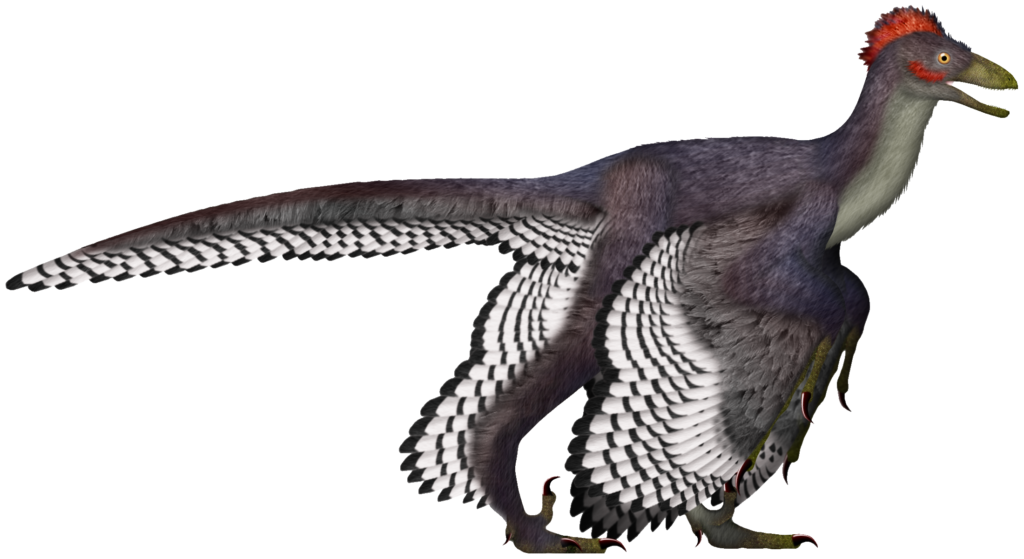
Anchiornis huxleyi has provided paleontologists with perhaps the most detailed color reconstruction of any dinosaur to date. This crow-sized feathered dinosaur from Late Jurassic China (approximately 160 million years ago) sported a dramatic black-and-white checkered pattern across its wings and legs. Its body was primarily covered in gray feathers, while its head was adorned with a rufous crest with black speckling. The striking monochromatic pattern of its limbs, created by white feathers with black tips, resembles the decorative techniques used in modern textile design. This elaborate pattern suggests that visual display played an important role in Anchiornis’s behavior, possibly for mate attraction or species recognition. The preservation quality was so exceptional that researchers could map melanosomes across the entire body, creating a comprehensive color guide that rivals what we know about many modern birds.
Borealopelta: The Reddish-Brown Armored Giant

The remarkable preservation of Borealopelta markmitchelli, an armored nodosaurid dinosaur discovered in Canada, has provided unprecedented insights into the coloration of larger dinosaurs. This tank-like herbivore, measuring approximately 18 feet long, possessed a reddish-brown pigmentation across its body. Chemical analysis of organic compounds in its fossilized skin revealed the presence of benzothiazole derivatives of pheomelanin, indicating reddish coloration. Surprisingly, researchers discovered that Borealopelta exhibited countershading—darker on top and lighter underneath—despite its massive size and formidable armor. This coloration pattern, typically associated with camouflage in smaller animals vulnerable to predation, suggests that even heavily armored dinosaurs faced significant predatory threats. The preservation of pigments in a large-bodied dinosaur demonstrates that color evidence isn’t limited to small, feathered species.
Caihong Juji: The “Rainbow Dinosaur”

Caihong juji, whose name translates to “rainbow with the big crest,” represents one of the most spectacularly colored dinosaurs discovered to date. This chicken-sized dinosaur from Jurassic China possessed iridescent feathers that would have shimmered with rainbow-like colors similar to modern hummingbirds. Microscopic analysis revealed platelet-shaped melanosomes in its head, neck, and tail feathers—a shape associated with iridescent colors in modern birds. What makes Caihong particularly special is that these structures are even more organized than those found in iridescent modern bird feathers, suggesting its plumage may have been even more brilliant. Additionally, Caihong featured a bony crest and elongated feathers forming a tail surface area similar to modern peacocks, indicating complex display behaviors. The discovery demonstrates that iridescent plumage evolved earlier in dinosaur evolution than previously recognized.
Archaeopteryx: The Black-Winged “First Bird”
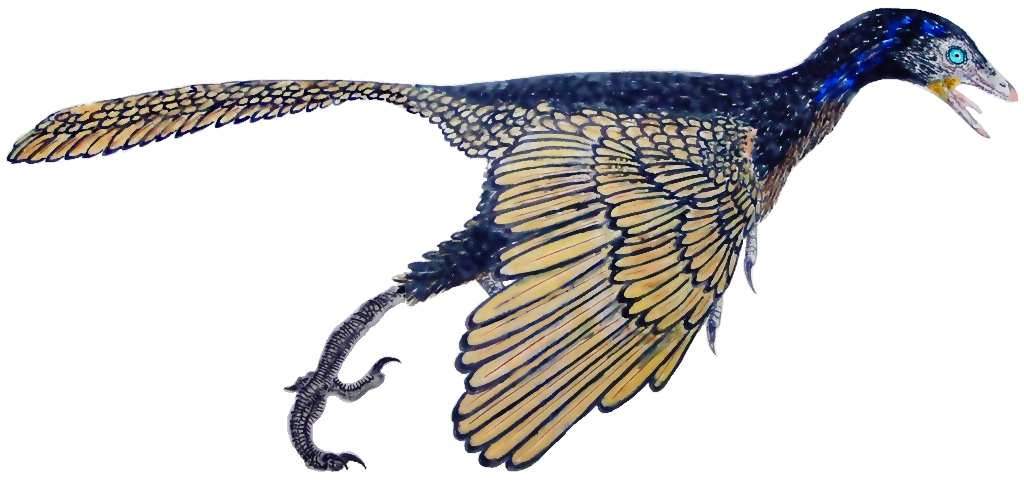
Archaeopteryx, often considered a transitional fossil between dinosaurs and birds, has now revealed its coloration through sophisticated analysis. Researchers examined an isolated feather using scanning electron microscopy and identified rod-shaped eumelanosomes, indicating the feather was primarily black. This discovery suggests that Archaeopteryx possessed black wing feathers, which may have served both in display and in structural reinforcement for primitive flight capabilities. The contrast between dark wings and what was likely a lighter body would have created a striking appearance for this Late Jurassic creature. Interestingly, the melanosomes in Archaeopteryx feathers are arranged in patterns consistent with those of modern flight feathers, suggesting a correlation between color and feather function that extends back 150 million years. This finding helps bridge our understanding between dinosaur coloration and that of modern birds.
Sinornithosaurus: The Yellow-Feathered Raptor
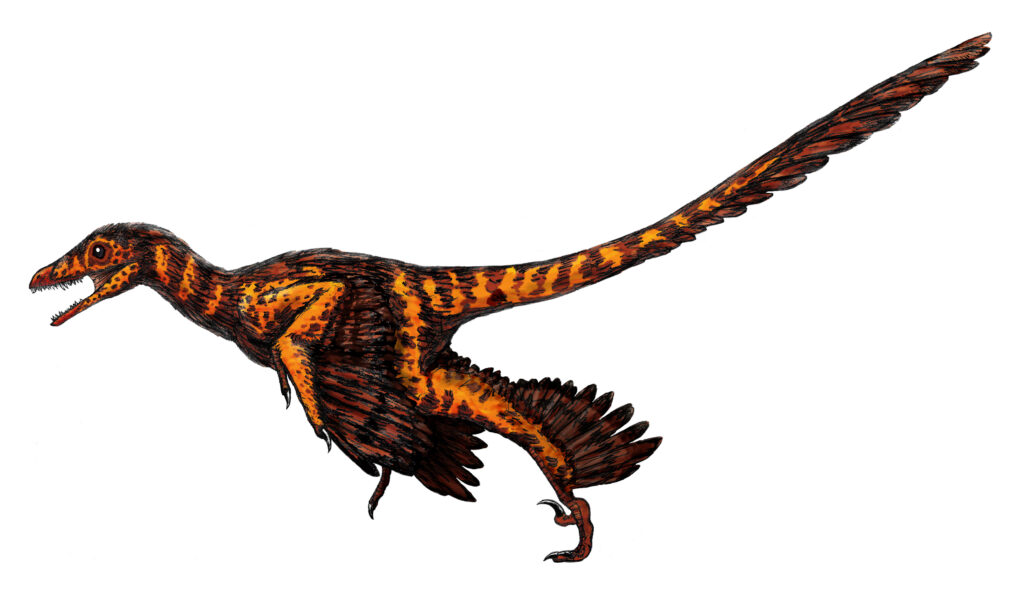
Sinornithosaurus, a feathered dromaeosaurid from Early Cretaceous China, has yielded evidence of yellowish and russet feathers covering its body. Microscopic examination revealed preserved melanosomes consistent with phaeomelanin, the pigment responsible for reddish-brown and yellow colors in modern animals. Particularly interesting was the distribution of these colors, with evidence suggesting a mottled or striped pattern that would have provided excellent camouflage in the forested environments this predator inhabited. The presence of yellow pigmentation is significant because it requires specific types of melanin and often serves in display functions in modern animals. Sinornithosaurus’s coloration adds to the growing evidence that dromaeosaurids—the “raptor” dinosaurs—were not the scaly, drab creatures portrayed in popular media but feathered, colorful animals more reminiscent of modern birds of prey with distinct patterning.
Primitive Coloration: Beyond Feathered Dinosaurs

While feathered dinosaurs have provided the most dramatic color evidence, researchers have also discovered pigmentation in more primitive dinosaur species. Recent studies have identified preserved melanin in the skin of hadrosaurs (duck-billed dinosaurs) and ceratopsians (horned dinosaurs), suggesting varying shades of brown, tan, and potentially even darker patterns across their bodies. In several cases, skin impressions show evidence of counter-shading and disruptive coloration patterns that would have helped these herbivores blend into their environments despite their large size. Particularly exciting are recent discoveries of pigment preservation in dinosaur eggs, indicating some species laid colored or speckled eggs similar to modern birds. These findings challenge the traditional conception that only small, feathered dinosaurs exhibited interesting coloration, demonstrating that the entire dinosaur family tree featured more visual diversity than previously thought.
The Evolutionary Significance of Dinosaur Colors

The discovery of diverse coloration across various dinosaur lineages has profound implications for understanding dinosaur evolution and behavior. The presence of complex color patterns indicates that visual signaling played a crucial role in dinosaur ecology, likely serving functions in mate selection, species recognition, and territorial display. Particularly significant is the evidence that iridescent and brilliant colors evolved in theropod dinosaurs long before the emergence of modern birds, suggesting sexual selection was a powerful force in dinosaur evolution. Counter-shading adaptations in various species demonstrate that predator-prey dynamics influenced coloration, even in armored species previously thought impervious to predation. The diverse pigmentation strategies now documented across multiple dinosaur families suggest that color vision was well-developed in these animals, requiring paleontologists to reconsider dinosaur sensory capabilities and social behaviors in light of these discoveries.
Technological Frontiers in Fossil Pigment Research
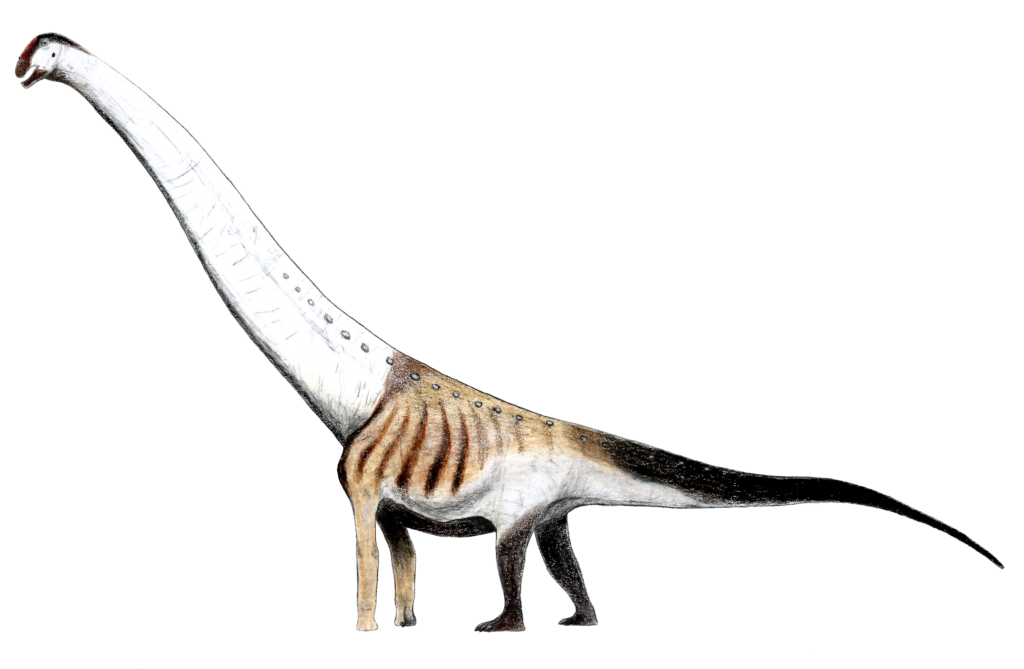
The field of fossil pigment research continues to advance with new technologies offering increasingly detailed insights into dinosaur coloration. Synchrotron rapid scanning X-ray fluorescence has recently allowed scientists to detect trace metals associated with specific pigments, expanding our ability to identify colors beyond just melanin. Techniques like time-of-flight secondary ion mass spectrometry (ToF-SIMS) can now detect chemical signatures of various pigments, including carotenoids responsible for bright yellows, oranges, and reds in modern birds. Researchers are also applying machine learning algorithms to predict coloration patterns in partially preserved specimens by recognizing subtle preservation patterns invisible to the human eye. These technological advances suggest we’re only scratching the surface of understanding dinosaur coloration, with future research likely to reveal even more vibrant and complex color patterns across diverse dinosaur species.
Challenges and Controversies in Dinosaur Color Research

Despite remarkable advances, the field of dinosaur coloration faces significant challenges and occasional controversies. Critics have questioned whether structures identified as melanosomes might instead be fossilized bacteria, leading researchers to develop rigorous protocols to distinguish between these possibilities. The preservation bias in the fossil record presents another challenge, as most color evidence comes from exceptional specimens found in specific geological contexts that facilitated rapid burial and minimal decomposition. This creates geographic and temporal gaps in our knowledge, particularly for dinosaurs from environments less conducive to preserving organic molecules. Additionally, current techniques primarily detect melanin-based pigments while missing others like carotenoids or structural colors, potentially underestimating the full spectrum of dinosaur coloration. These limitations remind us that while our understanding has dramatically improved, reconstructions still represent scientific best estimates rather than definitive portraits.
How Dinosaur Colors Changed Our View of Prehistoric Life

The discovery of dinosaur coloration has fundamentally transformed our perception of the Mesozoic world. What was once imagined as a landscape of drab, reptilian creatures has been reborn as a vibrant ecosystem filled with colorful, dynamic animals more akin to modern birds than reptiles. This paradigm shift extends beyond mere aesthetics—it has profound implications for understanding dinosaur behavior, ecology, and evolution. The presence of camouflage patterns tells us about predator-prey relationships, while display colors reveal aspects of social and sexual behavior previously inaccessible to paleontologists. Evidence of brilliant iridescence in dinosaurs predating birds by millions of years has rewritten the timeline of when complex display behaviors evolved. Perhaps most significantly, these discoveries have emotionally reconnected us with dinosaurs as once-living animals rather than skeletal monuments, bringing prehistoric ecosystems to life with unprecedented vividness and scientific accuracy.
Conclusion

The revelation of dinosaur colors represents one of paleontology’s most remarkable achievements, transforming our understanding of prehistoric life. Where once we saw dinosaurs through the monochromatic lens of fossilized bone, we now glimpse a world adorned with iridescent feathers, rusty red tails, black-and-white checkered patterns, and complex camouflage. These discoveries connect dinosaurs more firmly to their avian descendants while highlighting their unique adaptations. As technology continues to advance, we can expect even more colorful revelations from the fossil record, further bringing the distant past to life. The dinosaur world, once depicted in speculative greens and browns, has been reborn in living color, reminding us that science’s greatest achievement is not just explaining the world but revealing its wonder.

